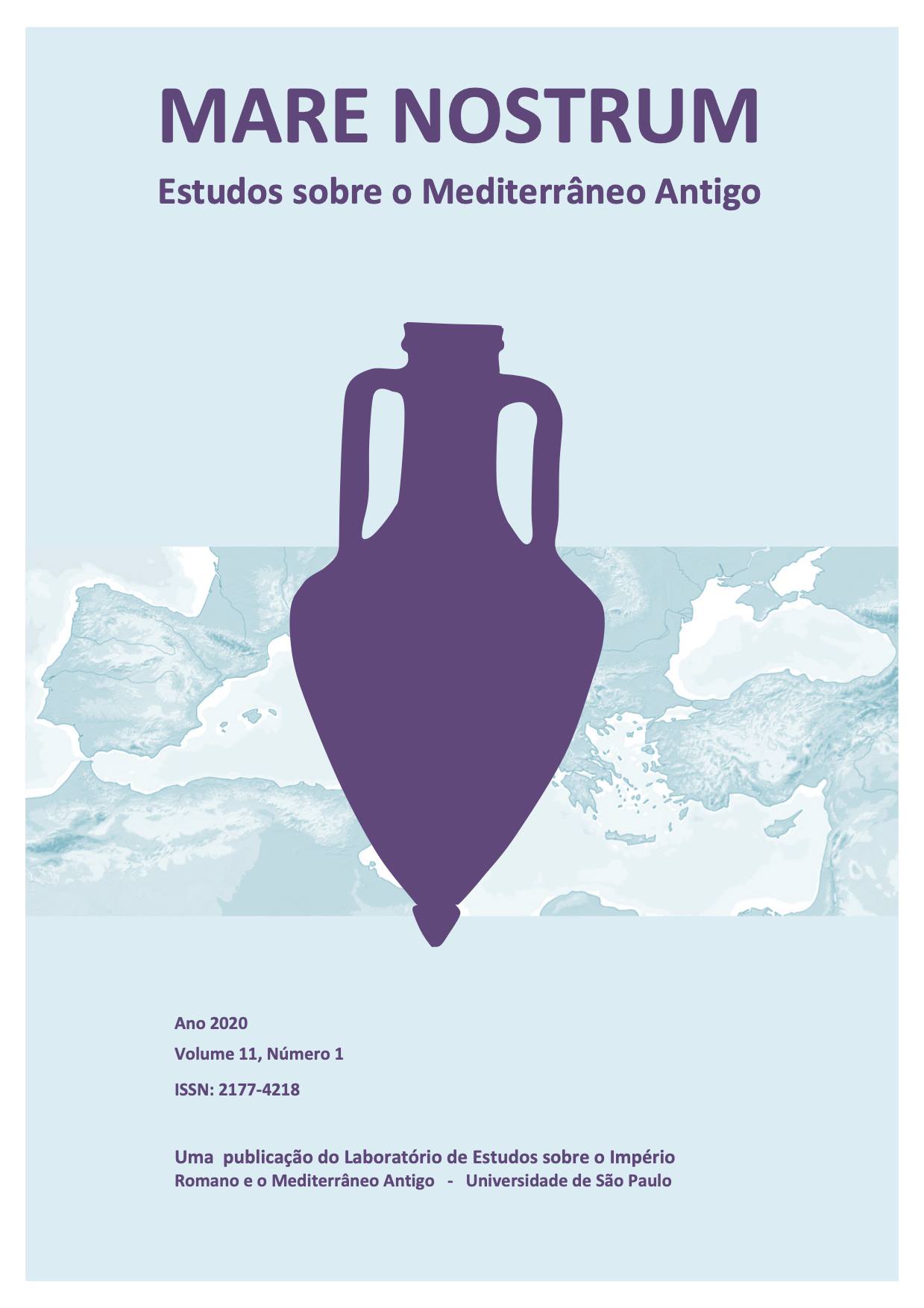Deianira and the death in bed: Gender and marriage in Sophocles’ Women of Trachis
DOI:
https://doi.org/10.11606/issn.2177-4218.v11i1p205-233Keywords:
Women of Trachis, Deianeira, marriage, bed, timéAbstract
This study analyzes Deianeira’s discourse in Sophocles’ Women of Trachis, examining issues related to marriage and the symbolism of the marital bed to establish a timḗ (honor) advocated by the tragic character. The analysis builds on a gender studies approach to Greek tragedy that seeks to locate a network of meanings about the status of women and their social function in order to track the character’s tragicity, oscillating between the powers of Eros and Aphrodite. The study examines the structure of Sophocles’ tragedy and his use of specific vocabulary to delineate a Deianeira connected to the oîkos.
Downloads
References
Adkins, L., & Adkins, R. (2005). HandbooktoLifeinAncient Greece.Facts On File.
Biggs, P. (Oct. de 1966). The Disease Theme in Sophocles' Ajax, Philoctetes and Trachiniae. Classical Philology, 61(4), 223–235.
Blundell, S. (1995). Women in Ancient Greece.Harvard University Press.
Boehringer, S. (2016). A sexualidade tem um passado? Doérôs grego à sexualidade contemporânea: questionamentos modernos ao mundo antigo. Bagoas (15), 14–32.
Boehringer, S., & Cuchet, V. S. (2011). Hommes et femmes dans l’Antiquité grecque et romaine.Colin.
Calame, C. (1992). The Poetics of Eros in Ancient Greece.Princeton University Press.
Carawan, E. (2000). Deianira's Guilt. Transactions of the American Philological Association, 189–237.
Detienne, M. (1988). Os Mestres da Verdade na Grécia Arcaica. JorgeZahar.
Easterling, P. E. (1968). Sophocles, Trachiniae. Bulletin of the Institute of Classical Studies(15), 58–69.
Fantham, E., Foley, Helene, P., Kampen, N. B., Pomeroy, S. B., & Shapiro, H. A. (1994). Women in the Classical World: Image and Text.Oxford University Press.
Farone, C. A. (2001). Ancient Greek Love Magic.Harvard University Press.
Hoey, T. F. (Autumn de 1979). The Date of the "Trachiniae". Phoenix, 33(3), 210–232.
Jebb, R. (2010). Introduction. In Sophocles, Sophocles, Vol. 5: The Plays and Fragments, With Critical Notes, Commentary, and Translation in English Prose; The Trachiniae(pp. IX–L). Cambridge University Press.
Loraux, N. (1981). Le Lit, la guerre. L'Homme, 21(1), 37–67.
Loraux, N. (1988). Maneiras Trágicasde Mataruma Mulher: Imaginárioda Grécia Antiga.Jorge Zahar.
Meier, C. (2004). De la tragédie grecque comme art politique.Les Belles Lettres.
Mateus Dagios. Dejanira e a morte no leito.
Mills, S. (2017). The Women of Trachis. Em R. Lauriola, & K. N. Demetriou, Brill’s Companion to the Reception of Sophocles(512–557). Brill.
Musurillo, H. (1961). Fortune's Wheel: The Symbolism of Sophocles' Women of Trachis. Transactions and Proceedings of the American Philological Association, 92, 372–383.
Oliveira, F. R. (2009). Apresentação, introdução e comentário filológico. Em Sófocles, As Traquínias.(Ed. bilíngue). Editora da Unicamp.
Pozzi, D. C. (Nov. de 1994). Deianeira's Robe: Diction in Sophocles' "Trachiniae". Mnemosyne, 47 (5), 577–585.
Romilly, J. d. (1970). La Tragédie Grecque.PUF.
Scott, J. (jul./dez de 1995). Gênero: uma categoria útil de análise histórica. Educação & Realidade, 20 (2), 71–99.
Segal, C. (1975). The Hydra Nursling: Image and Action in Trachiniae. L'antiquité classique, 44 (2), 612–617.
Segal, C. (1995). Sophocles' Tragic World: Divinity, Nature, Society.Harvard University Press.
Sófocles. (1996). As traquínias.(Zambujo Fialho, Maria do Céu, trad). UnB.
Sófocles. (2009). As Traquínias.(Apresentação, introdução e comentário filológico de Flávio Ribeiro de Oliveira). (Ed. bilíngue). Editora da Unicamp.
Sófocles. (2014). Sófocles / As Traquínias.(T. Vieira, trad.). Ed. 34.
Thévenet, L. (2009). Le personnage : du mythe au théâtre. La question de l’identité dans la tragédie grecque.Les Belles Lettres.
Várzeas, M. (2009). Amor e amizade em Sófocles. Em B. Pereira, & J. Deserto, Symbolon I: Amor e Amizade(19–29). FLUP.
Vernant, J.-P. (1999). Tensões e ambiguidades na Tragedia Grega. In Vernant, J. P. & Vidal-Naquet P., Mito e tragédia na Grécia Antiga(7–24). Perspectiva.
Vernant, J.-P. (2006). Mito e sociedade na Grécia antiga.José Olympio.
Vernant, J.-P., & Vidal-Naquet, P. (1999). Mito e tragédia na Grécia Antiga.Perspectiva.
Mare Nostrum, ano 2020, v. 11, n. 1.232Vidal-Naquet, P. (2002). Le Miroir brisé. Tragédie athénienne et politique.Les Belles Lettres.
Wender, D. (1974). The will of the beast: sexual imagery in the Trachiniae. Ramus,3 (1), 1–17.Wilkins, J. (2000). The Boastful Chef: The Discourse of Food in Ancient Greek Comedy.Oxford University Press.
Zeitlin, F. (Summer de 1985). Playing the Other: Theater, Theatricality, and the Feminine in Greek Drama. Representations (11), 63–94
Downloads
Published
Issue
Section
License
Copyright (c) 2020 Mateus Dagios

This work is licensed under a Creative Commons Attribution 4.0 International License.
Responsibility for the content published by Mare Nostrum rests exclusively with the author(s) of such content.
The reproduction of the texts published by Mare Nostrum is licensed according to Creative Commons license Attribution-NonCommercial 4.0 International (CC BY-NC).
Authors who publish with this journal agree to the following terms:
- Authors retain copyright and grant the journal right of first publication with the work simultaneously licensed under a Creative Commons Attribution License that allows others to share the work with an acknowledgement of the work's authorship and initial publication in this journal.
- Authors are able to enter into separate, additional contractual arrangements for the non-exclusive distribution of the journal's published version of the work (e.g., post it to an institutional repository or publish it in a book), with an acknowledgement of its initial publication in this journal.
- Authors are permitted and encouraged to post their work online (e.g., in institutional repositories or on their website) prior to and during the submission process, as it can lead to productive exchanges, as well as earlier and greater citation of published work (See The Effect of Open Access).









